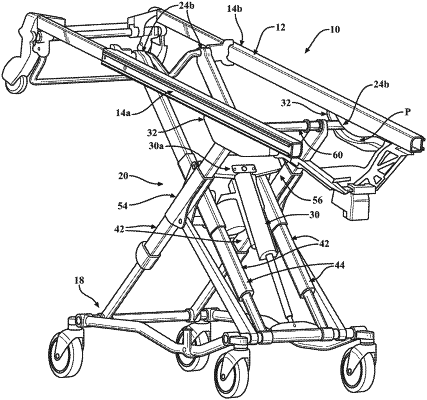| CPC A61G 7/018 (2013.01) [A61G 7/012 (2013.01); A61G 7/1073 (2013.01); A61G 1/0262 (2013.01); A61G 7/08 (2013.01); A61G 2203/30 (2013.01); A61G 2203/34 (2013.01)] | 20 Claims |

|
1. A patient transport apparatus for supporting patients of different weights, the patient transport apparatus comprising:
a base;
a litter comprising a patient support surface to support patients of different weights;
a lift mechanism to facilitate arranging the litter at different heights relative to the base between a plurality of lift configurations including a fully-retracted configuration and a fully-extended configuration, the lift mechanism comprising:
an actuator defining a cylinder supporting a piston coupled to a rod and arranged for movement along the cylinder,
a fluid reservoir, and
a pump driven by a motor to direct hydraulic fluid from the fluid reservoir to the cylinder;
a sensor configured to output a signal indicative of a magnitude of pressure in the cylinder;
a user interface comprising an input control arranged for user engagement to operate the lift mechanism; and
a controller disposed in communication with the motor, the sensor, and the user interface, the controller being configured to determine a target parameter for the motor based on the signal generated by the sensor for adjusting operation of the motor relative to weight supported on the litter and, in response to user engagement with the input control, drive the motor at the target parameter to effect movement of the litter relative to the base at a predetermined rate, the predetermined rate being substantially the same for patients of different weights supported on the litter, the controller being configured to adjust the target parameter for the motor while driving the motor based on changes occurring in the signal generated by the sensor to dampen hydraulic oscillation acting on the actuator and maintain the predetermined rate.
|